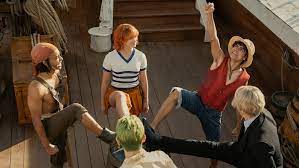The live-action adaptation of an anime or manga is only somewhat less cursed than a live-action television show or movie based on a video game. Surprisingly, 2023 is anticipated to be a record year for both. The popular drama “The Last of Us,” which follows the 2013 video game’s somber, character-driven zombie apocalypse, had its HBO premiere in January. With excellent reviews, high viewership, and numerous Emmy nominations, “The Last of Us” successfully defied a long-standing tradition. A few months later, “The Super Mario Bros.” movie would achieve a similar accomplishment in terms of box office receipts, albeit not quite in terms of reviews.
As the popular streaming service prepared to debut “One Piece,” a series based on the enduring manga created and drawn by Eiichiro Oda, it’s possible that Netflix observed this pattern with some interest. Similar projects have a troubled past, something Netflix is well aware of. In addition to well-known flops from outside studios like “Ghost in the Shell,” starring Scarlett Johansson, and “Dragonball Evolution,” Netflix has financed everything from the critically panned “Death Note” to the hastily shelved “Cowboy Bebop.”
Netflix is in a perfect position to reposition a cultural export like “One Piece” for a new and distant audience thanks to its deep pockets and global reach, but from personal experience, it is aware of how difficult a process can be due to intensely possessive fans, wary stakeholders, and the indescribable qualities of animation. “The Last of Us” at least now provides a best-case scenario to consider.
Netflix has equipped itself in response to that. Taking advantage of the euphoric enthusiasm for the show and the cast at this summer’s Tudum fan event, co-showrunners Matt Owens and Steven Maeda turned the first 100 chapters of the manga into eight hour-long episodes, which Oda publicly approved. Subscribers can either prepare for or postgame with the 15 seasons of the “One Piece” anime already available to stream. It appears almost certain that “One Piece” will be an economic success and that it will appease fans whose guiding principle is loyalty to the original.
However, despite the fact that this “One Piece” works well as both a tribute and an introduction for beginners, it is nonetheless constrained by its fruitless attempt to painstakingly replicate a world made for two dimensions
“One Piece” is a nautical tale that pits pirate crews searching for a mythical treasure—hidden, you got it, in one piece—against marines trying to uphold law and order. Iaki Godoy’s character, Monkey D. Luffy, a teenage boy with aspirations of ruling the pirates, acquires a ship and assembles a crew over the course of the season. Each member of the crew has aspirations of their own. To become the best blade fighter in the world, swordsman Roronoa Zoro (Mackenyu), thief Nami (Emily Rudd), chef Sanji (Taz Skyler), and cheery Usopp (Jacob Romero Gibson) all have similar goals. Meanwhile, Chef Sanji seeks to locate a renowned source of innovative ingredients.
For want of a better word, the universe in which this journey takes place is cartoonish. The mystical Gum Gum Fruit that Luffy consumed as a child gave the sailor his renowned capacity to stretch his body like rubber. The Straw Hat Pirates, named after Luffy’s treasured, always-present headgear, come across fishermen, snail phones, and a deadly clown (Jeff Ward) who can dismember his own body as they go. While yelling “Gum Gum Pistol,” Luffy’s hallmark action is to whip back an extended, noodle-like limb, and the ship he commands has a huge goat skull on the bow.
The pilot’s director Marc Jobst, production designer Richard Bridgland, costume designer Diana Cilliers, and countless other team members create a purposefully dissonant symphony of practical and computer-generated effects in this visual mayhem. A prologue in which former pirate king Gold Roger (Michael Dorman) drives a sizable audience waiting for his death into a treasure-hungry frenzy portrays the story’s epic scale. Hand-to-hand battle scenes are expertly choreographed. When it works, “One Piece” is a candy-colored treat with a gleeful innocence that matches its simple coming-of-age story.
These initiatives frequently transport the viewer, but they also call to mind the “One Piece” series’ original medium and highlight how awkward live-action can be when adapted from it, no matter the cost. A human-sawtooth shark hybrid wearing an open Hawaiian shirt is never going to appear normal when entering a restaurant. Even the regular cast exhibits a stiff but vivacious acting style. Godoy is frequently endearing, however when he applauds and raises his hand in Luffy’s signature position, he holds the motion for a few beats too long, almost as if mimicking a still image. The effect is strange, but more significantly, it raises a more fundamental query.
What does this adaptation of “One Piece” offer that the original couldn’t, if the best one can hope for is a close or distant representation of the original?
“One Piece” is in the vein of some of Netflix’s best success stories, like “Wednesday,” “The Witcher,” “The Sandman,” “The Umbrella Academy,” and other genre programs that parody intellectual property, even as it recalls the patchy history of anime adaptations in the past. Aside from the “Wednesday” dance, these shows are both immensely popular and culturally insensitive. They have a smoothness about them that encourages binges, makes viewers feel unchallenged, and works against establishing actual novelty. However, originality was never the intention here.
All objectives are legitimate as long as we never give up on them, Luffy would say, and preservation is one of them.
The entire first season of “One Piece” is now available on Netflix.

